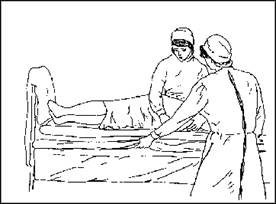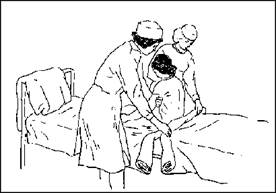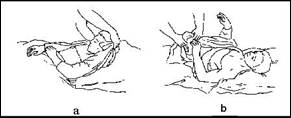Fig.6 Transportation of the patient
For the sake of convenience a trolley can be put with relation to the bed under the right angle, in parallel or sequentially. A patient should be transported on a trolley with caution with the head end of the trolley in the direction of travel .
Work of the nurse in a ward, division
The course and outcome of a disease depend to a great extent on the environment the patient is in: this is first of all hygienic conditions in the ward, a good bed, observance of rules of personal hygiene, provision of timely and proper meals for the patient.
The sanitary-and-epidemiologic mode in a medical division includes wet cleaning of all the premises, maintenance in them of due cleanliness and order, sanitary-and-hygienic processing of patients.
For creating favorable conditions in a ward an assistant nurse arranges her work depending on the day plan.
By time patients get up, i.e. by 7 am, the assistant nurse should be in her work place with the stock ready for the patients’ morning toilet and room cleaning. She turns on the light in the ward. While the nurse takes temperature, the assistant nurse airs the room, opens the windows or transoms. She gives a basin and water for hyposthenic patients to wash, and washes seriously ill patients herself, she then takes away spittoons, bedpans and, re-makes beds, gives bedpans and urine bags to patients; before breakfast she collects urine or stool for laboratory analysis. The assistant nurse washes seriously ill patients with gatism, after which she gets everything ready for the morning cleaning of the ward.
During breakfast after changing her clothes and carefully washing her hands the assistant nurse helps the nurse to feed patients. After a breakfast she starts cleaning the wards. By the time of the doctor’s round the ward should be clean.
Ward cleaning:
1. Transoms are opened and the ward is aired. In the winter time all the patients should be carefully covered with blankets tucked under their feet and bodies.
2. Cleaning is carried out in the wet way for there is plenty of microbes in the dust, which can cause various diseases in hyposthenic patients. Wet cleaning should be done no less than 2 times a day with the usage of disinfectants (chlorine solution, chloramine, sulphochlorontyne, “Dezoxon-1” and others).
Rules of preparing disinfectant
chlorine-containing working
solutions
Preparation of disinfectantsshould be carried out centrally, i.e. in specially equipped premises (having a forced-air and exhaust ventilation).
1. Clear solution of chloride of lime is prepared in the following way: 1 kg of dry chloride of lime is carefully mixed with a small amount of water. Thenup to 10 liter of cold water is added and it is placed in a dark room in glass bottles (16-20 liter of the solution is usually prepared). The solution should be defecated for 12 hours. After that it is poured into a dark bottle and corked thus 10 % clear solution of chloride of lime is produced. It can be kept up to 5 - 7 days in toilet rooms or special rooms in a dark place since it decays in the light.
2. Then different concentrations of working solution of chloride of lime are prepared:
0,2 %: 200 ml of 10 % solution of chlorinated lime is dissolved in 9,8 liter of water (it is usually used for washing utensils);
0,5 % - 500 ml of 10 % solution of chlorinated lime is dissolved in 9,5 liter of water);
1 % - 1 liter of 10 % solution of chlorinated lime is dissolved in 9,0 liter of water (the last two solutions are usually used for washing baths and toilets)
3. Chloramine solution is prepared just prior to using (chloramine, unlike chlorinated lime, is added to the needed amount of water and then stirred):
2 % - 20 g chloramine is added to 980 ml of water;
5 % - 50 g chloramine is added to 950 ml of water.
Cleaning is carried out with a brush, a mop, or cloths moistened with disinfectant.
Chamber cleaning should start with bedside tables: they are dusted, all extra things are cleared away; the following items can remain: soap, toothpaste, cookies, jam, sweets, books. Fruits and perishable food should be kept in a refrigerator. Then the surfaces of radiators, pipes, window-sills, plafonds, beds and other pieces of furniture are wiped. The cleaning process should be quiet; the movements of the assistant nurse should not disturb patients. Cleaning should be thorough, not a single corner or a hard-to-get place should be left out. A chamber should be swept in the direction of the door; the litter should be collected into a shovel and taken away into the chute or burned.
After lunch damp sweeping with disinfectant and ward airing are done. Depending on the season during day time sleep (hush hour) it is desirable to leave transoms open. The assistant nurse should maintain quietness (all kinds of cleaning, loud conversations, circulation, banging doors, telephone conversations) are forbidden. The patients’ sleep should not be disturbed is indispensable, since it strengthens a weak organism. After the nap the younger nurse treats patients to tea.
After supper assistant nurse wipes the floor with a wet cloth, airs the ward helps the nurse to execute evening prescriptions ( gives enemas, washes seriously ill patients, etc.), covers seriously ill patients with blankets and turns off the light in chambers.
After patients go to sleep the medical attendants should supervise the patients’ sleep, and take care of the seriously ill and restless patients.
Cleaning corridors and back rooms is to be done daily and at regular hours. In the corridor doors are wiped with a damp cloth, as well as the panel, furniture, and door handles. Cleaning ends up with washing the floor with clear solution of chlorinated lime. Bowls, toilet bowls, urinals, tanks for water storage, spittoons are washed daily with hot water with soap and disinfectant solution. Baths, bed-pans and urine bags are washed and disinfected after each use with 0,5% solution of chlorinated lime. Toilet rooms should be well isolated from other premises, have the intermediate sluice, reliably functioning exhaust ventilation, and sufficient illumination. They should contain lockers for keeping bed-pans, urine bags, vessels for collecting stool and urine. Cleaning inventory should be separate for wards and for toilet rooms; it should be used strictly according to the assigned purpose, marked correspondingly and kept clean. Brushes, rags, and basins are to be washed on a regular basis with hot water, and rags are to be dried. Ruffs and mops for washing bed-pans and urine bags are also washed with water and then disinfected. Bed-pans and urine bags are carefully washed with water and disinfected with 2 % chloramine solution. If an infectious intestinal disease is diagnosed in a patient, his stool is kept in 2 % chloric solution for 2 hours, after which the bed-pan is emptied. Clean bed-pans and urine bags are kept in toilet rooms in special wells. In some hospitals bed-pan washing machines are purchased. Toilet rooms are cleaned as required and aired well so that there is no bad smell. Bowls, urines and toilet bowls are washed every day with 2 % soda solution, brown stains are wiped off with acetic acid. The assistant nurse should do the cleaning in rubber gloves, after cleaning she has to wash her hands with soap and disinfectant 2% chloramine solution, which should be in store in each toilet room.
The Patient’s Personal Hygiene
Observing the rules of personal hygiene, keeping the ward and the bed clean is necessary for effective treatment.
 The patient’s position in bed must be comfortable, bed linen must be clean, the bed wire-netting must be tight, the mattress – flat. For serious patients and those with urinary and fecal incontinence an oilcloth is put on the mattress-case. For women with abundant excretion the oilcloth is put under a diaper, which is changed as soon as it gets dirty but not rarer than twice a week. Serious patients are put on functional beds with head-rests. The patient is given 2 pillows and a blanket with a blanket slip. Beds are relayed regularly before and after sleep.
The patient’s position in bed must be comfortable, bed linen must be clean, the bed wire-netting must be tight, the mattress – flat. For serious patients and those with urinary and fecal incontinence an oilcloth is put on the mattress-case. For women with abundant excretion the oilcloth is put under a diaper, which is changed as soon as it gets dirty but not rarer than twice a week. Serious patients are put on functional beds with head-rests. The patient is given 2 pillows and a blanket with a blanket slip. Beds are relayed regularly before and after sleep.
 Changing Bed Linen
Changing Bed Linen
and Underclothes
Bed linen and underclothes are changed regularly but not rarer than once a week, after the hygienic bath (if the severity of the patient’s state permits that). In certain cases bed linen is changed when necessary.
If patients are allowed to walk, they can change underclothes and bed linen themselves. If the severity of the disease confines him to bed, bed lined is changed by the nurse who is assisted by the aid-woman.
There are several ways of changing bed linen for the serious patients.
First method. The dirty sheet from under the head and legs is rolled up into a bolster and removed. The clean sheet, rolled up into a bolster at both ends as bandage, is carefully put under the patient’s sacrum and then straightened in the direction of the head and the legs. The sheet must be without hems, patches or folds.
Second method. The patient is moved to one side of the bed and lies sidelong, the dirty sheet is rolled up into a bolster, the clean sheet is put on the bed and the patient is moved back. On the other side of the bed the rolled dirty sheet is removed, the clean one straightened.
Bed linen must be changed by 2 people to minimize the patient’s efforts. It should be mentioned that changing bed linen for the serious patients must be done with great caution and skill (fig.7).

Fig.7. Changing the sheet of a serious patient (first method)
If the patient is allowed to sit, then to change bed linen the nurse moves the patient from the bed to a chair and the aid-woman changes the linen (fig.8).
The sheet must cover not only the mattress and its sides but also the flat ends. The edges of the sheet must not hang down, they should be tucked under the mattress from all sides. It is possible to fasten the sheet to the mattress, so that it wouldn’t crumple and purse.

Fig.8. Changing the sheet of a serious patient (second method)
Dirty linen is collected in plastic bags and immediately carried out of the ward. Before sending it to the laundry the linen must be kept in a specially assigned room (dirty linen-room) in tanks or other containers. The section matron must see to it that the aid-woman always has several clean beddings in stock. In her turn, the nurse is to check that every morning the aid-woman hands in dirty linen and takes the clean, counting each bedding.
When changing underclothes the nurse puts her hands under the patient’s sacrum, grasps the edge of the shirt and carefully pulls it up to the head. After that both hands of the patient should be put up, the shirt, rolled up near the neck, is pulled over the head, so that the hands become free (fig. 9а). The clean shirt is put on in the reverse order (fig. 9 b).

Fig. 9. Changing the shirt:
